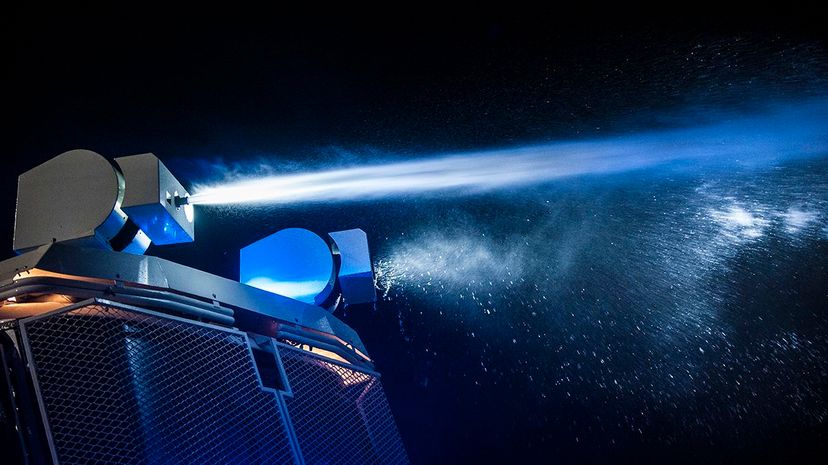
Adam Leggat spent more than two decades in the British Army, much of it as an officer in the Royal Irish Regiment. His specialty: conducting counterterrorism and crowd-management operations.
So when Leggat tells you that, if you ever find yourself in the middle of a riot, to avoid the business end of a fully operational water cannon ... well, it's best you believe him.
Advertisement
"We have people in Northern Ireland who riot regularly. Several times every summer," Leggat, an expert with The Densus Group, a Texas-based risk management company, says from Northern Ireland. "We've got some quite experienced rioters. And they hate it. They ab-so-lute-ly hate it. They will drive stolen cars straight into it. They have attempted to throw planks with nails in front of it so it will puncture the tires. They have shot at it. They hate it. They want it to go away. It is a very, very effective tool."
Water cannons have been in the news recently after a clash Sunday between police and protesters in Cannon Ball, North Dakota. The protesters are trying to halt the completion of the Dakota Access Pipeline, a more than 1,100-mile (1,770-kilometer) crude oil pipeline that runs from North Dakota to Illinois. Some consider the pipeline an environmental hazard. Others see it as threatening sacred Native American lands, specifically those of the Standing Rock Sioux tribe.
Area law enforcement converged on Cannon Ball on Sunday and employed a makeshift water cannon. It was basically a fire-hose nozzle perched atop a 15-ton armored personnel carrier owned by the Stutsman County Sheriff's Office — against the protesters.
It was a nasty melee, complete with rocks thrown, tear gas released and rubber bullets fired. Several people were injured. The water — video showed it being sprayed at and over the protesters — didn't help on a 23-degree F (minus 5-degree C) night.
It could have been worse, though. It could have been a real water cannon.
Breaking Out the Big Guns
In several other spots around the world, authorities regularly use water cannons to quell riots. True water cannons are more than high-powered hoses run from a fire truck or hooked to a hydrant.
Water cannons often are armored, too, to repel extra-dangerous crowds. The higher-end ones are equipped with two cannons atop the vehicle and have video cameras on the cannons that not only aid in aiming the weapons — it's a better vantage point from on top — but record the whole confrontation, too.
The cannons are manned by highly trained officers inside the vehicle, who watch video monitors and control the cannons via a joystick.
"You can target it specifically at people within the crowd who are being violent without affecting everyone in the crowd, like something like gas. You can literally pick out who to target," Leggat says. "The water cannon is probably THE most effective less-lethal weapon that I've ever worked alongside anywhere in the world."
Less-lethal?
"Some people use the term nonlethal. That's a very common term in the U.S. We, as a company, don't use it," he says. "There's no such thing as nonlethal force. You can have an accident with any of those weapons."
The Power of Water
The power of the cannon's stream is variable. One water cannon, built in Germany, shoots a stream of water at up to 18 liters per second, enough to easily bowl over a person, writes Robert Booth at the Guardian. The power differs, too, with how far away the target is or how direct the hit is.
At close range, though, a water cannon is extremely accurate and can be extremely dangerous, as this protester in Istanbul found out.
It can be even more dangerous than that. A German man was blinded by a blast from a water cannon in 2010. After spending 10 months in a coma, a 69-year-old South Korean man died earlier this year as the result of a water cannon blast, prompting a plea to the Office of the United Nations High Commissioner for Human Rights to investigate.
London police bought three water cannons in 2015, but Theresa May, then the country's Home Secretary, blocked their rollout, saying that the cannons had the potential for injury, sent the wrong message and would "change the face of British policing."
"The risks with water cannons are lower than with most less-lethal weapons," Leggat says. "But that doesn't mean there is no risk."
Still, many places — Northern Ireland, India, Germany, Turkey, South Korea, France, Denmark, the Netherlands and Belgium among them — continue to use them to disperse a crowd before violence erupts. The threat of their use often is an effective deterrent in itself. "I have seen violent crowds disperse literally because the water cannons have driven up," Leggat says.
Nobody wants to be on the wrong end when the water is released.
Advertisement


